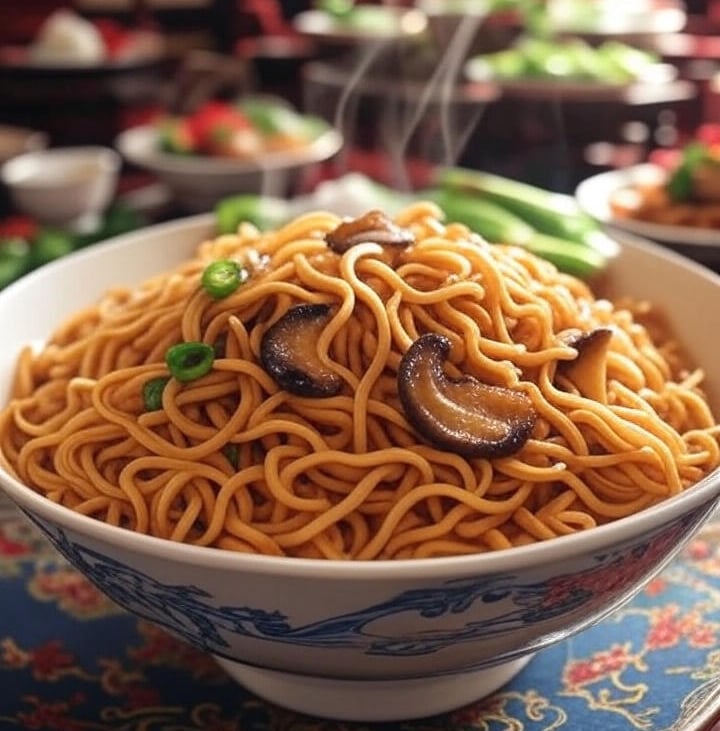Welcome to Noodles of Asia ! - A Woke Noodle Blog
Celebrating E-fu Noodles: A Cantonese Classic


Hello, noodle enthusiasts! If you’ve ever enjoyed a plate of silky, golden noodles with a rich, savory sauce, you might have tasted e-fu noodles—a cherished staple in Cantonese cuisine. Made from wheat flour and often enriched with eggs, these thin, springy noodles are a highlight of festive meals and everyday dining alike. Whether stir-fried with mushrooms or served with a luxurious sauce, e-fu noodles bring a delightful texture and flavor to the table. In this post, we’ll explore their origins, history, interesting facts, and a few recipes to inspire your next culinary journey. Let’s dig in!
Origins and History of E-fu Noodles
E-fu noodles, also known as yi mein or e-fu mian, originated in southern China, particularly in the Guangdong province, during the Qing Dynasty (1644–1912). Named after the chef who reportedly invented them, they became a symbol of longevity and good fortune due to their chewy texture, which resists breaking. Traditionally served during celebrations like birthdays and the Lunar New Year, e-fu noodles spread through Chinese diaspora communities, especially in Hong Kong and overseas Chinatowns, where they evolved into a beloved dish by the 20th century.
Interesting Facts About E-fu Noodles
E-fu noodles are steeped in tradition and flavor! Here are some fascinating tidbits:
Longevity Symbol: Their unbroken strands represent long life, making them a must-have at festive gatherings.
Egg Enrichment: The golden hue comes from egg yolks, adding richness to the wheat-based dough.
Dry Pan-Frying: Traditionally, e-fu noodles are pre-cooked and pan-fried to enhance their chewy texture before final preparation.
Versatile Pairings: Often served with shiitake mushrooms, seafood, or soy-based sauces, reflecting Cantonese culinary flair.
Global Adaptation: In Western countries, e-fu noodles appear in fusion dishes with ingredients like broccoli or oyster sauce.
These facts highlight their cultural significance and culinary adaptability.
Famous E-fu Noodle Recipes
E-fu noodles shine in a variety of dishes, from festive feasts to quick meals. Here are some classics to try. (Note: These are overviews—adjust to taste and check full recipes online for details.)
E-fu Noodles with Mushrooms: Stir-fried with shiitake and oyster mushrooms in a savory soy sauce—a vegetarian delight.
Seafood E-fu Noodles: Tossed with shrimp, scallops, and a light oyster sauce, perfect for celebrations.
Chicken E-fu Noodles: Noodles with tender chicken and ginger in a rich broth or stir-fry.
Vegetable E-fu Noodles: Packed with bok choy, carrots, and a touch of sesame oil—a healthy option.
E-fu Noodles with Crab: Luxurious crab meat and roe with a silky sauce, a festive favorite.
Plain E-fu Noodles: Simply stir-fried with soy sauce and scallions for a quick, flavorful dish.
For a fun challenge, try making e-fu noodles at home: Knead wheat flour with eggs, roll into thin sheets, cut into strands, and pan-fry—or use pre-made noodles for ease.
Wrapping It Up
E-fu noodles are a delicious bridge to Cantonese heritage, symbolizing prosperity and joy with every bite. Whether you’re preparing a festive spread or a cozy meal, they offer a perfect blend of texture and taste. Next time you’re at a Chinese restaurant or experimenting in your kitchen, give e-fu noodles a try. What’s your favorite way to enjoy them? Share in the comments below—I’d love to hear! Until next time, happy eating! 🍜
